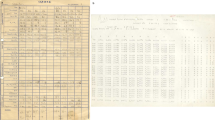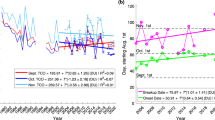Abstract
The observed depletion of the ozone layer from the 1980s onwards is attributed to halogen source gases emitted by human activities. However, the precision of this attribution is complicated by year-to-year variations in meteorology, that is, dynamical variability, and by changes in tropospheric ozone concentrations. As such, key aspects of the total-column ozone record, which combines changes in both tropospheric and stratospheric ozone, remain unexplained, such as the apparent absence of a decline in total-column ozone levels before 1980, and of any long-term decline in total-column ozone levels in the tropics. Here we use a chemistry–climate model to estimate changes in halogen-induced ozone loss between 1960 and 2010; the model is constrained by observed meteorology to remove the effects of dynamical variability, and driven by emissions of tropospheric ozone precursors to separate out changes in tropospheric ozone. We show that halogen-induced ozone loss closely followed stratospheric halogen loading over the studied period. Pronounced enhancements in ozone loss were apparent in both hemispheres following the volcanic eruptions of El Chichon and, in particular, Mount Pinatubo, which significantly enhanced stratospheric aerosol loads. We further show that approximately 40% of the long-term non-volcanic ozone loss occurred before 1980, and that long-term ozone loss also occurred in the tropical stratosphere. Finally, we show that halogen-induced ozone loss has declined by over 10% since stratospheric halogen loading peaked in the late 1990s, indicating that the recovery of the ozone layer is well underway.
This is a preview of subscription content, access via your institution
Access options
Subscribe to this journal
Receive 12 print issues and online access
$259.00 per year
only $21.58 per issue
Buy this article
- Purchase on Springer Link
- Instant access to full article PDF
Prices may be subject to local taxes which are calculated during checkout





Similar content being viewed by others
References
World Meteorological Organization, Scientific Assessment of Ozone Depletion: 2010, Global Ozone Research and Monitoring Project Report 52 (WMO, 2011).
United Nations Environment Programme Environmental Effects of Ozone Depletion: 2010 Assessment (UNEP, 2010).
Kiesewetter, G., Sinnhuber, B. M., Weber, M. & Burrows, J. P. Attribution of stratospheric ozone trends to chemistry and transport: A modelling study. Atmos. Chem. Phys. 24, 12073–12089 (2010).
Shepherd, T. G. Dynamics, stratospheric ozone, and climate change. Atmos. Ocean 46, 371–392 (2008).
Hegglin, M. I. & Shepherd, T. G. Large climate-induced changes in UV index and stratosphere-to-troposphere ozone flux. Nature Geosci. 2, 687–691 (2009).
Solomon, S. et al. The role of aerosol variations in anthropogenic ozone depletion at northern midlatitudes. J. Geophys. Res. 101, 6713–6727 (1996).
Eyring, V. et al. Multi-model projections of stratospheric ozone in the 21st century. J. Geophys. Res. 112, D16303 (2007).
Randel, W. J. & Wu, F. A stratospheric ozone profile data set for 1979–2005: Variability, trends, and comparisons with column ozone data. J. Geophys. Res. 112, D06313 (2007).
Cionni, I. et al. Ozone database in support of CMIP5 simulations: Results and corresponding radiative forcing. Atmos. Chem. Phys. 11, 11267–11292 (2011).
Fioletov, V. E., Bodeker, G. E., Miller, A. J., McPeters, R. D. & Stolarski, R. Global and zonal total ozone variations estimated from ground based and satellite measurements: 1964–2000. J. Geophys. Res. 107, 4647 (2002).
Lamarque, J-F. et al. Tropospheric ozone evolution between 1890 and 1990. J. Geophys. Res. 110, D08304 (2005) 10.1029/2004JD005537
Marenco, A., Gouget, H., Nédélec, P., Pagés, J-P. & Karcher, F. Evidence of a long-term increase in tropospheric ozone from Pic du Midi data series: Consequences: Positive radiative forcing. J. Geophys. Res. 99, 16617–16632 (1994).
Parrish, D. D. et al. Long-term changes in lower tropospheric baseline ozone concentrations at northern mid-latitudes. Atmos. Chem. Phys. 12, 11485–11504 (2012).
Reader, M. C., Plummer, D. A., Scinocca, J. F. & Shepherd, T. G. Contributions to 20th century total column ozone change from halocarbons, tropospheric ozone precursors, and climate change. Geophys. Res. Lett. 40, 6276–6281 (2013).
Mäder, J. A. et al. Statistical modeling of total ozone: Selection of appropriate explanatory variables. J. Geophys. Res. 112, D11108 (2007).
Vyushin, D. I., Fioletov, V. E. & Shepherd, T. G. Impact of long-range correlations on trend detection in total ozone. J. Geophys. Res. 112, D14307 (2007).
Hadjinicolaou, P., Pyle, J. A., Chipperfield, M. P. & Kettleborough, J. A. Effect of interannual meteorological variability on mid-latitude O3. Geophys. Res. Lett. 24, 2993–2996 (1997).
in SPARC Report on the Evaluation of Chemistry-Climate Models (eds Eyring, V., Shepherd, T. G. & Waugh, D. W.) Stratospheric Processes And their Role in Climate. SPARC Report No. 5, WCRP-132, WMO/TD-No. 1526 (SPARC CCMVal, 2010)
Feng, W., Chipperfield, M. P., Dorf, M., Pfeilsticker, K. & Ricaud, P. Mid-latitude ozone changes: Studies with a 3-D CTM forced by ERA-40 analyses. Atmos. Chem. Phys. 9, 2357–2369 (2007).
Dee, D. P. et al. The ERA-Interim reanalysis: Configuration and performance of the data assimilation system. Q. J. R. Meteorol. Soc. 656, 553–597 (2011).
Uppala, S. M. et al. The ERA-40 re-analysis. Q. J. R. Meteorol. Soc. 612, 2961–3012 (2005).
Tegtmeier, S. et al. The SPARC Data Initiative: A comparison of ozone climatologies from international limb satellite sounders. J. Geophys. Res. 118, 12229–12247 (2013).
World Meteorological Organization, Scientific Assessment of Ozone Depletion: 2006, Global Ozone Research and Monitoring Project Report 50 (WMO, 2007).
Plummer, D. A., Scinocca, J. F., Shepherd, T. G., Reader, M. C. & Jonsson, A. I. Quantifying the contributions to stratospheric ozone changes from ozone depleting substances and greenhouse gases. Atmos. Chem. Phys. 10, 8803–8920 (2010).
Wegner, T. et al. Heterogeneous chlorine activation on stratospheric aerosols and clouds in the Arctic polar vortex. Atmos. Chem. Phys. 12, 11095–11106 (2012).
Portmann, R. W. et al. Role of aerosol variations in anthropogenic ozone depletion in the polar regions. J. Geophys. Res. 101, 22991–23006 (1996).
Lamarque, J-F. et al. Historical (1850–2000) gridded anthropogenic and biomass burning emissions of reactive gases and aerosols: Methodology and application. Atmos. Chem. Phys. 10, 7017–7039 (2010).
Newman, P. A., Daniel, J. S., Waugh, D. W. & Nash, E. R. A new formulation of equivalent effective stratospheric chlorine (EESC). Atmos. Chem. Phys. 7, 4537–4552 (2007).
Stolarski, R. S., Douglass, A. R., Steensrud, S. & Pawson, S. Trends in stratospheric ozone: Lessons learned from a 3D chemical transport model. J. Atmos. Sci. 63, 1029–1041 (2006).
Hadjinicolaou, P., Pyle, J. A. & Harris, N. R. P. The recent turnaround in stratospheric ozone over northern middle latitudes: A dynamical modeling perspective. Geophys. Res. Lett. 32, 12821 (2005).
Dhomse, S., Weber, M., Wohltmann, I., Rex, M. & Burrows, J. P. On the possible causes of recent increases in northern hemispheric total ozone from a statistical analysis of satellite data from 1979 to 2003. Atmos. Chem. Phys. 6, 1165–1180 (2006).
Telford, P., Braesicke, P., Morgenstern, O. & Pyle, J. Reassessment of causes of ozone column variability following the eruption of Mount Pinatubo using a nudged CCM. Atmos. Chem. Phys. 9, 4251–4260 (2009).
Poberaj, C. S., Staehelin, J. & Brunner, D. Missing stratospheric ozone decrease at Southern Hemisphere middle latitudes after Mount Pinatubo: A dynamical perspective. J. Atmos. Sci. 68, 1922–1945 (2011).
Randel, W. J. & Cobb, J. B. Coherent variations of monthly mean total ozone and lower stratospheric temperature. J. Geophys. Res. 99, 5433–5447 (1994).
Young, P. J. et al. Pre-industrial to end 21st century projections of tropospheric ozone from the Atmospheric Chemistry and Climate Model Intercomparison Project (ACCMIP). Atmos. Chem. Phys. 13, 2063–2090 (2013).
Scinocca, J., McFarlane, N. A., Lazare, M., Li, J. & Plummer, D. Technical Note: The CCCma third generation AGCM and its extension into the middle atmosphere. Atmos. Chem. Phys. 8, 7055–7074 (2008).
Sander, S. P. et al. Chemical Kinetics and Photochemical Data for Use in Atmospheric Studies, Evaluation Number 15. JPL Publication 06-2 (Jet Propulsion Laboratory, 2006).
IPCC Special Report on Emissions Scenarios: A Special Report of Working Group III of the Intergovernmental Panel on Climate Change (Cambridge Univ. Press, 2000).
Shindell, D. T. et al. Improved attribution of climate forcing to emissions. Science 326, 716–718 (2009).
McLandress, C., Scinocca, J. F., Shepherd, T. G., Reader, M. C. & Manney, G. L. Dynamical control of the mesosphere by orographic and non-orographic gravity wave drag during the extended northern winters of 2006 and 2009. J. Atmos. Sci. 70, 2152–2169 (2013).
Weber, M. et al. Stratospheric Ozone, in ‘State of the Climate in 2011’. Bull. Am. Meteorol. Soc. 93, S46–S49 (2012).
World Meteorological Organization, Meteorology–A Three-Dimensional Science WMO Bull vol. 6 134–138 (WMO, 1957).
Remsberg, E. et al. On the quality of the Nimbus 7 LIMS version 6 ozone for studies of the middle atmosphere. J. Quant. Spectrosc. Rad. Transfer 105, 492–1031 (2007).
Wang, H. J., Cunnold, D. M. & Bao, X. A critical analysis of stratospheric aerosol and gas experiment ozone trends. J. Geophys. Res. 101, 12495–12514 (1996).
Wang, H. J., Cunnold, D. M., Thomason, L. W., Zawodny, J. M. & Bodeker, G. E. Assessment of SAGE version 6.1 ozone data quality. J. Geophys. Res. 107, 4691 (2002).
Von Clarmann, T. et al. Retrieval of temperature, H2O, O3, HNO3, CH4, N2O, ClONO2 and ClO from MIPAS reduced resolution nominal mode limb emission measurements. Atmos. Meas. Technol. 2, 159–175 (2009).
Remsberg, E. et al. On the inclusion of Limb Infrared Monitor of the Stratosphere version 6 ozone in a data assimilation system. J. Geophys. Res. 118, 7982–8000 (2013).
Stolarski, R. S. & Frith, S. M. Search for evidence of trend slow-down in the long-term TOMS/SBUV total ozone data record: The importance of instrument drift uncertainty. Atmos. Chem. Phys. 6, 4057–4065 (2006).
Fioletov, V. E. & Shepherd, T. G. Seasonal persistence of midlatitude total ozone anomalies. Geophys. Res. Lett. 30, 1417 (2003).
Acknowledgements
This work was financially supported by the Canadian Space Agency through the CMAM20 project, with additional institutional support from the Canadian Centre for Climate Modelling and Analysis who provided the model code and supercomputing time.
Author information
Authors and Affiliations
Contributions
T.G.S. conceived the experiment, interpreted the results, and wrote the paper; D.A.P. performed the diagnostic analysis and devised the bias-correction procedure; J.F.S. devised and implemented the nudging procedure used to perform the experiments; M.I.H. performed the analysis of stratospheric partial column ozone and contributed to the writing; V.E.F. processed and provided the ground-based data and contributed to the interpretation; M.C.R. performed the simulations; and E.R., T.v.C. and H.J.W. processed and provided the LIMS, MIPAS and SAGE data, respectively.
Corresponding author
Ethics declarations
Competing interests
The authors declare no competing financial interests.
Supplementary information
Supplementary Information
Supplementary Information (PDF 1334 kb)
Rights and permissions
About this article
Cite this article
Shepherd, T., Plummer, D., Scinocca, J. et al. Reconciliation of halogen-induced ozone loss with the total-column ozone record. Nature Geosci 7, 443–449 (2014). https://doi.org/10.1038/ngeo2155
Received:
Accepted:
Published:
Issue Date:
DOI: https://doi.org/10.1038/ngeo2155
This article is cited by
-
Exploring the driving forces of long-term total ozone change: based on data from a ground based station at the northern mid-latitude over 1958–2018
Theoretical and Applied Climatology (2022)
-
Challenges for the recovery of the ozone layer
Nature Geoscience (2019)
-
Evidence of illegal emissions of ozone-depleting chemicals
Nature (2018)
-
Stratospheric ozone loss over the Eurasian continent induced by the polar vortex shift
Nature Communications (2018)
-
Detecting recovery of the stratospheric ozone layer
Nature (2017)



